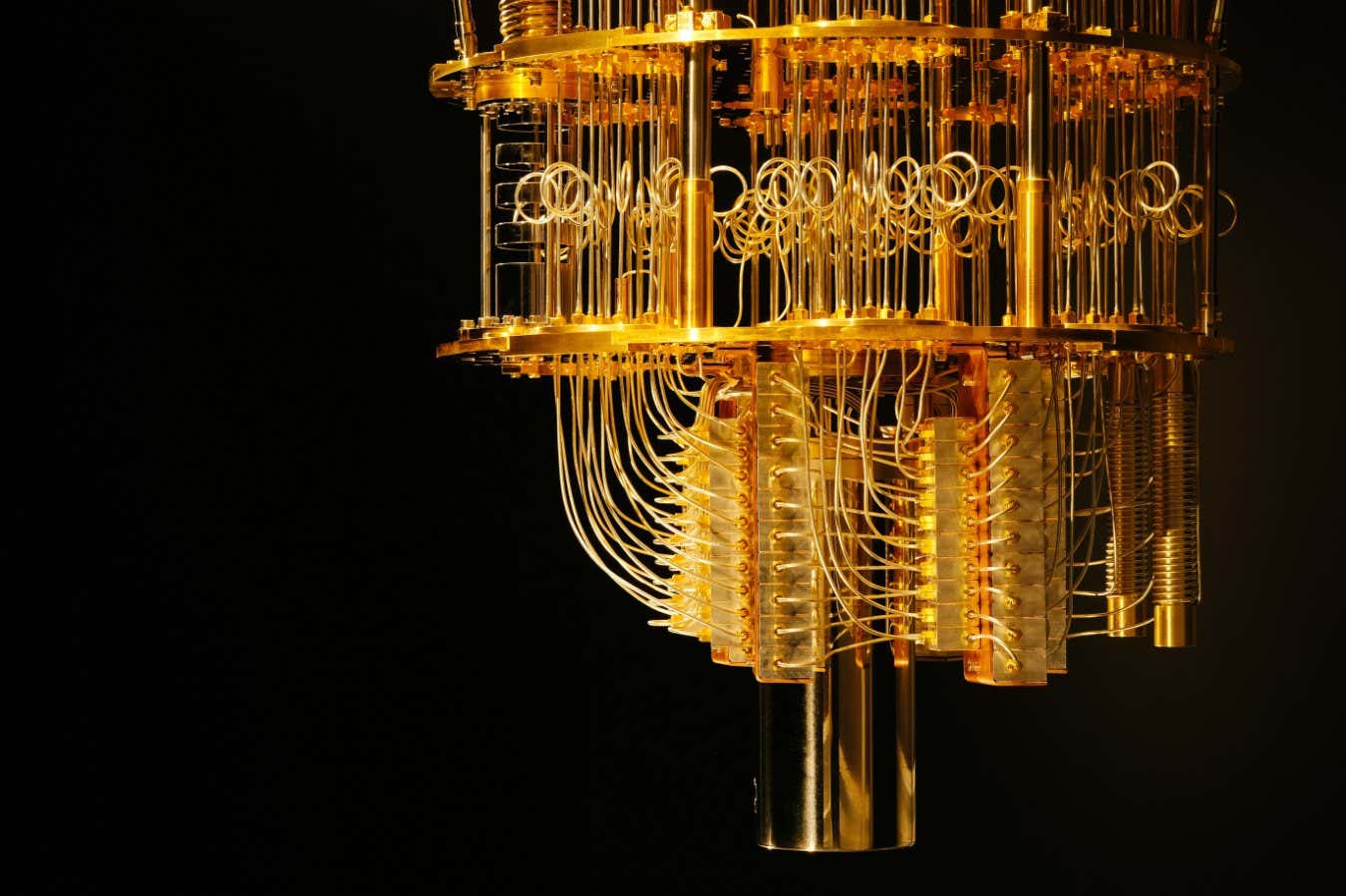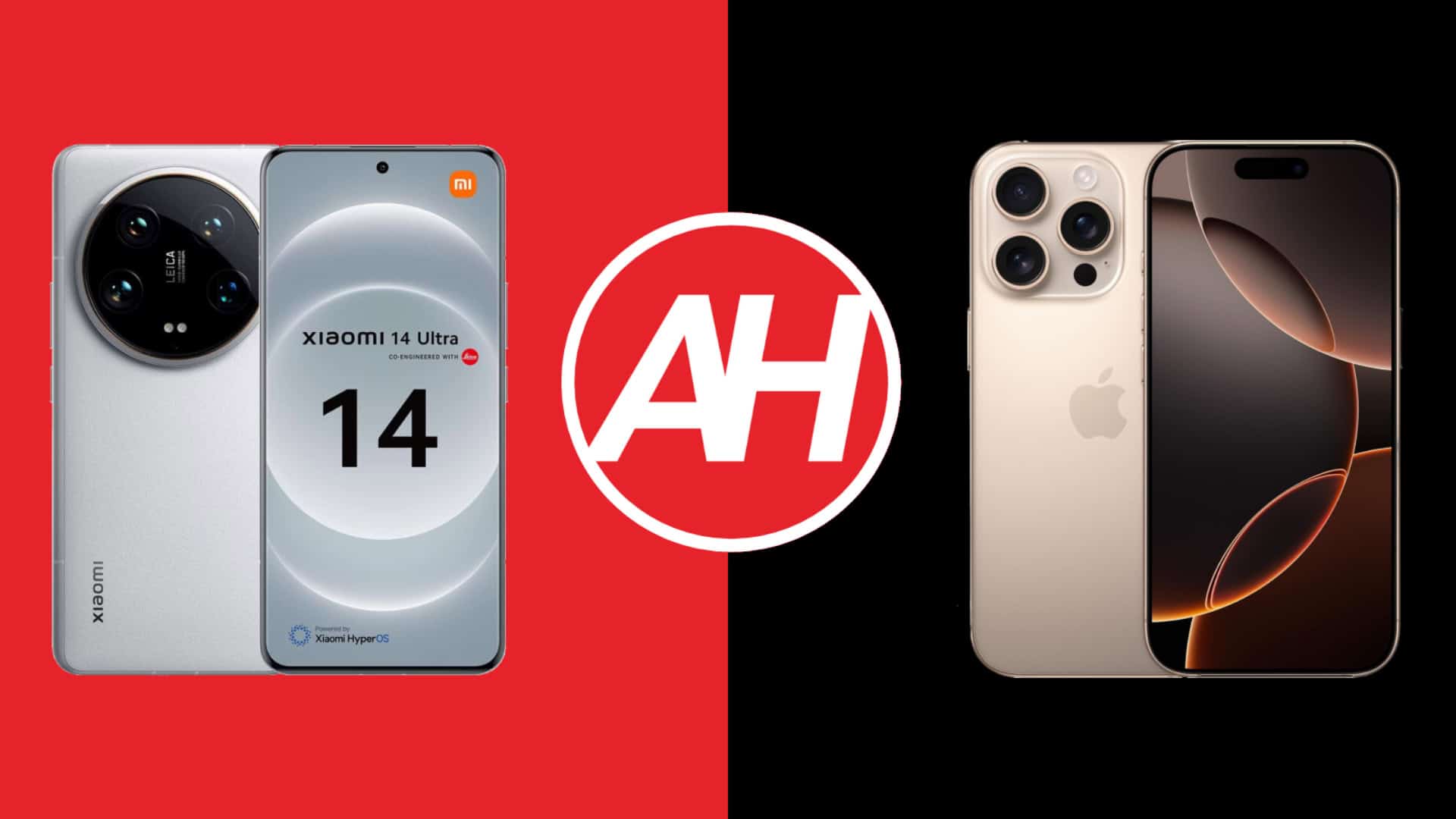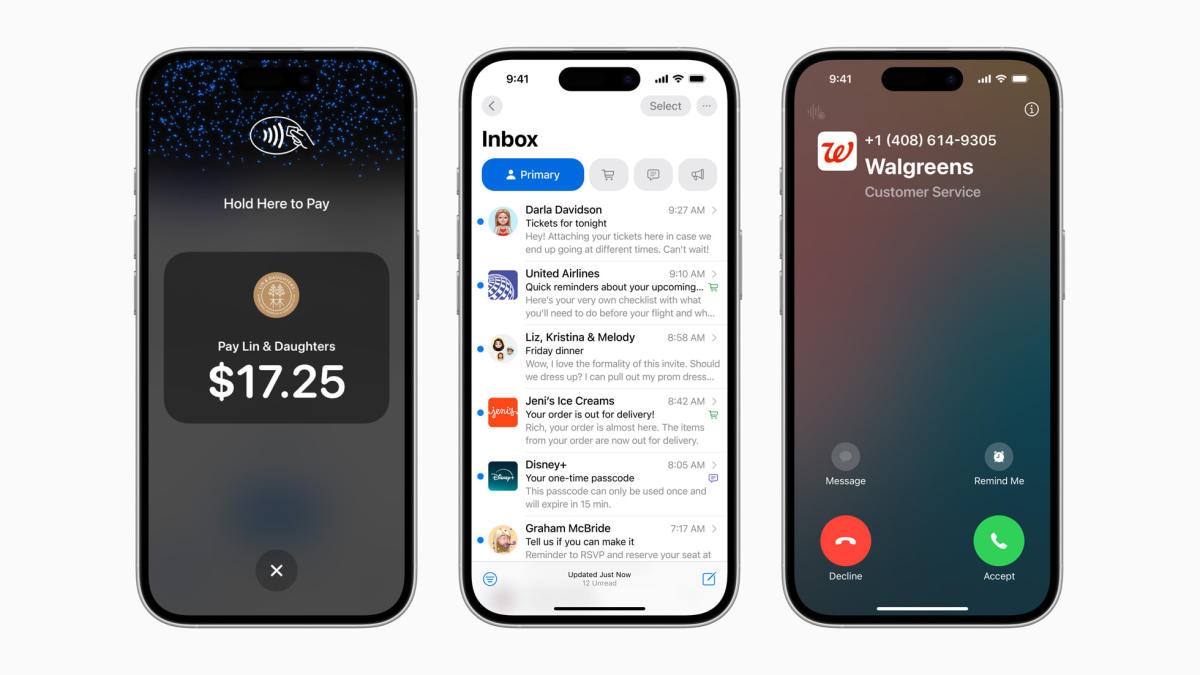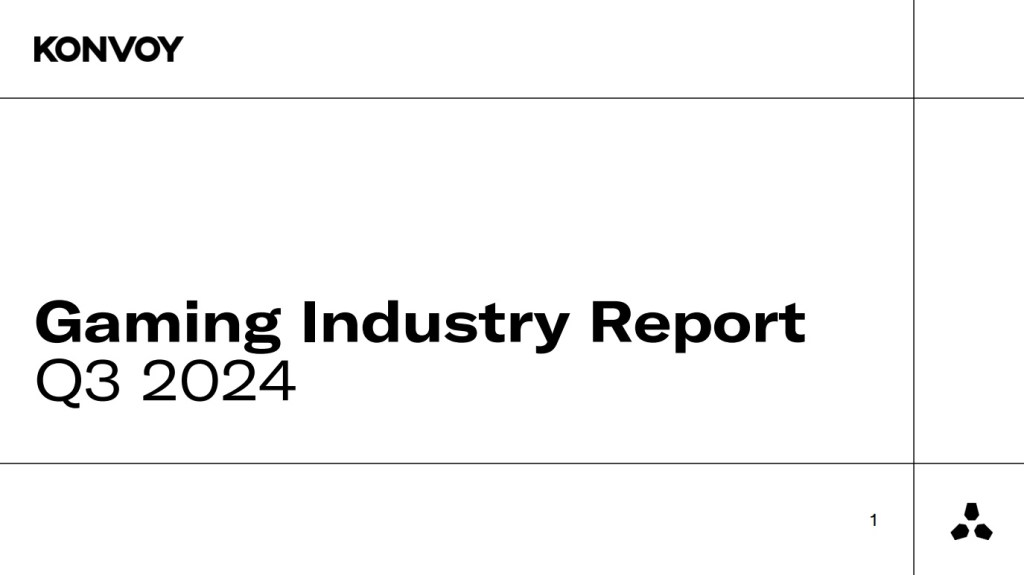Technology
How ‘quantum software developer’ became a job that actually exists


Quantum computers need programmers
IBM
Quantum computers, which promise to revolutionise everything from chemistry to cancer research, aren’t quite ready for the mainstream yet – but that hasn’t prevented the emergence of a new breed of quantum software developers.
“Writing a program for a quantum computer used to mean getting a PhD,” says Lov Grover. He would know – his Grover’s algorithm, created in 1996 for searching a database with a quantum computer, was one of the first pieces of quantum software. At that time, there were no quantum computers that could actually run it, and the work…
Technology
SpaceX to top the Super Heavy catch with another astonishing feat


SpaceX achieved a spectacular first on Sunday when it used a pair of giant mechanical arms to catch the 70-meter-tall Super Heavy booster just minutes after it deployed the Starship spacecraft to orbit in the vehicle’s fifth test flight.
But SpaceX isn’t stopping there. As part of its efforts to create a fully reusable spaceflight system for the Starship — comprising the first-stage Super Heavy booster and the upper-stage Starship spacecraft — SpaceX will attempt to catch not only the booster, but also the spacecraft.
SpaceX CEO Elon Musk confirmed the plan for the world’s most powerful rocket in a post on X ( formally Twitter) on Wednesday, saying, “Hopefully early next year, we will catch the ship too.”
Before then, SpaceX will want to carry out more test flights of the Starship in which it will continue to catch the Super Heavy, while the Starship will continue to come down in the ocean, as it did in Sunday’s test flight.
Catching the Starship back at the launch base will allow for a faster turnaround time between launches, with the spacecraft only needing to be checked, refurbished, and refueled before being lifted atop a Super Heavy for another flight.
SpaceX also has to perfect a landing system for the Starship that involves it touching down on the ground in a vertical position, as this is how it will arrive on other celestial bodies such as the moon and possibly Mars (at least until any launch and landing infrastructure can be built).
It’s actually already achieved such a landing in Earth-based tests several years ago, but those touchdowns involved shorter “hops” into the atmosphere rather than more complex orbital flights.
It’s certainly an exciting time for SpaceX engineers as they put much of their attention into the continued development of the Starship.
NASA is planning to use SpaceX’s spacecraft to put two astronauts on the lunar surface in the Artemis III mission, which is currently scheduled for 2026, so there is much work to be done.
Technology
Xiaomi 14 Ultra vs Apple iPhone 16 Pro Max

Both Xiaomi and Apple launched very compelling flagship smartphones this year. In this article, we’ll compare the two. It’s the comparison between the Xiaomi 14 Ultra vs Apple iPhone 16 Pro Max. These two phones are actually quite different in every way. Their internals are far different, and so are their designs. They are both large-format smartphones, though, and do have some things in common.
The Xiaomi 14 Ultra arrived back in February this year, while the iPhone 16 Pro Max followed in December. Both phones are available globally, and both of them are actually quite pricey. Comparing them makes all the sense in the world. We’ll first list their specifications, and will then move to a number of other categories, including design, display, performance, battery, cameras, and audio.
Specs
Xiaomi 14 Ultra vs Apple iPhone 16 Pro Max, respectively
– Screen size:
6.73-inch LTPO AMOLED display (curved, adaptive 120Hz, 3,000 nits max brightness)
6.9-inch LTPO Super Retina XDR OLED ( flat, 120Hz, HDR, 2,000 nits)
– Display resolution:
3200 x 1440
2868 x 1320
– SoC:
Qualcomm Snapdragon 8 Gen 3
Apple A18 Pro (3nm)
– RAM:
16GB (LPDDR5X)
12GB/16GB (LPDDR5X)
– Storage:
512GB (UFS 4.0)
256GB/512GB/1TB (NVMe)
– Rear cameras:
50MP (wide, f/1.6-f/4.0 variable aperture, OIS, multi-directional PDAF, 1.6um pixel size), 50MP (ultrawide, f/1.8 aperture, 122-degree FoV, 0.7um pixel size, dual pixel PDAF), 50MP (telephoto, f/1.8 aperture, 0.7um pixel size, dual pixel PDAF, OIS, 3.2x optical zoom), 50MP (periscope telephoto, f/2.5 aperture, 0.7um pixel size, dual pixel PDAF, OIS, 5x optical zoom)
48MP (wide, f/1.8 aperture, 1/1.28-inch sensor, 1.22um pixel size, sensor-shift OIS), 48MP (ultrawide, f/2.2 aperture, 0.7um pixel size, PDAF), 12MP (periscope telephoto, f/2.8 aperture, 1/3.06-inch sensor, 1.12um pixel size, 3D sensor-shift OIS, 5x optical zoom).
– Front cameras:
32MP (wide, f/2.0 aperture, 0.7um pixel size)
12MP (f/1.9 aperture, PDAF, 1/3.6-inch sensor size, OIS)
– Battery:
5,000mAh
4,685mAh
– Charging:
90W wired, 80W wireless,, 10W reverse wireless (charger included)
38W wired, 25W MagSafe, 15W Qi2 wireless, 7.5W Qi wireless, 4.5W reverse wired (charger not included)
– Dimensions:
161.4 x 75.3 x 9.2mm
163 x 77.6 x 8.3 mm
– Weight:
219.8 grams
227 grams
– Connectivity:
5G, LTE, NFC, Wi-Fi, USB Type-C, Bluetooth 5.4/5.3
– Security:
In-display fingerprint scanner & facial scanning
Face ID (3D facial scanning)
– OS:
Android 14 with HyperOS
iOS 18
– Price:
€1,499
$1,199+
– Buy:
Xiaomi 14 Ultra (Amazon)
Apple iPhone 16 Pro Max (Apple)
Xiaomi 14 Ultra vs Apple iPhone 16 Pro Max: Design
The Xiaomi 14 Ultra is made out of aluminum and glass. The thing is, there is a vegan leather model out there too, but only in China. There is also a variant with a titanium frame, but only in China. The iPhone 16 Pro Max, on the other hand, is made out of titanium and glass. There is only one variant in terms of build materials. The iPhone 16 Pro Max is slightly taller, wider, and thinner than the Xiaomi 14 Ultra. It’s heavier than the global variant of the Xiaomi 14 Ultra, but lighter than one of the models of Xiaomi’s flagship, it all depends. Both phones are set between 220 and 230 grams, though, so they’re not particularly light.
You’ll find flat sides on both of these phones, though the implementation is a bit different. The Xiaomi 14 Ultra’s back side is not completely flat, unlike what the iPhone 16 Pro Max offers. A flat display is included on both phones, though, along with thin bezels. The Xiaomi 14 Ultra has a display camera hole at the top of its display, while the iPhone 16 Pro Max includes a pill-shaped cutout known as Dynamic Island.
The Xiaomi 14 Ultra has its power/lock and volume rocker buttons on the right-hand side. Those are the only buttons included on the phone. The iPhone 16 Pro Max has two more. It includes its power/lock button on the right side, along with the Camera Control key. On the left, you’ll find the volume up and down buttons, and the Action Button. The Xiaomi 14 Ultra also has an IR blaster at the top.
You’ll notice a big camera oreo on the back of the Xiaomi 14 Ultra. Four cameras sit in there, and that camera island does protrude quite a bit on the back. The iPhone 16 Pro Max has a much smaller camera island in the top-left corner of its back. Three cameras sit on the inside. Both smartphones are IP68 certified for water and dust resistance. They’re both quite slippery too, though the vegan leather model of the Xiaomi 14 Ultra does add more grip.
Xiaomi 14 Ultra vs Apple iPhone 16 Pro Max: Display
The Xiaomi 14 Ultra features a 6.73-inch 3200 x 1440 LTPO AMOLED display. That panel is flat, and it supports an adaptive refresh rate of up to 120Hz. It also supports Dolby Vision and HDR10+ content. The peak brightness here is 3,000 nits, in theory, and the screen-to-body ratio is at around 89%. The display aspect ratio is 20:9, while the Xiaomi Shield Glass protects this display.

The iPhone 16 Pro Max, on the other hand, has a 6.9-inch 2868 x 1320 LTPO Super Retina XDR OLED display. This display is also flat, and it offers an adaptive refresh rate of up to 120Hz. HDR10 content is supported, as is HDR10 content, while the peak brightness is at 2,000 nits. The screen-to-body ratio sits at around 91%, while the display aspect ratio is 19.5:9. The Ceramic Shield glass protects this display.
Both of these displays are great. They’re both sharp, vivid, and have great viewing angles. They also get more than bright enough and have those inky blacks that people love. The Xiaomi 14 Ultra’s panel does get a bit brighter when needed. It also supports high-frequency PWM dimming, unlike the iPhone 16 Pro Max’s panel. Both displays do offer really good touch response, though. You’ll likely be more than happy with either one of these two panels.
Xiaomi 14 Ultra vs Apple iPhone 16 Pro Max: Performance
The Xiaomi 14 Ultra is fueled by the Snapdragon 8 Gen 3 processor, a 4nm chip. That is still Qualcomm’s best chip, even though its successor is coming later this month. That chip is backed with up to 16GB of LPDDR5X RAM and UFS 4.0 flash storage. The iPhone 16 Pro Max is fueled by the Apple A18 Pro processor, which is a 3nm chip. That processor is backed by 8GB of RAM and NVMe flash storage. Neither phone supports storage expansion, by the way.
Both of these processors are immensely powerful, as are both phones in general. In day-to-day use, no matter what you use them for, both smartphones deliver outstanding performance. They’re very snappy in every way, handling browsing, image editing, multimedia consumption, and everything else is not a problem. Getting both phones to stutter is not an easy task, actually.
The same can be said for gaming. They can play simpler games without a problem, and the same goes for semi-demanding and truly graphically-demanding games. Both of these phones can handle even the most demanding games on their respective app stores without a problem. They both get warm, but not too warm nor does that affect their gaming performance. Genshin Impact, for example, is not a problem for either phone.
Xiaomi 14 Ultra vs Apple iPhone 16 Pro Max: Battery
A 5,000mAh battery sits inside the global Xiaomi 14 Ultra model. The Chinese variant does include a 5,300mAh unit, but that’s not the one we used. The iPhone 16 Pro Max features a 4,685mAh battery. Apple’s iPhones always have smaller battery packs than their Android counterparts, mainly due to the differences in how iOS and Android function. That doesn’t have to mean that the iPhone 16 Pro Max has worse battery life. And in this case, it does not.
The Xiaomi 14 Ultra has great battery life in its own right, but the iPhone 16 Pro Max shades it in that regard. Both smartphones can go up to 7 hours of screen-on-time, and then some. The iPhone 16 Pro Max always has more battery juice left at that point, quite a bit more. We were able to push it way past that point. In all honesty, the Xiaomi 14 Ultra can also go higher than that, but it cannot keep up with the iPhone 16 Pro Max.
Do note that we gaming does affect battery life quite a bit, as do other demanding tasks. Even when we did play games during the day, both of these phones were able to go the distance. Their battery life is so good that even demanding users will be pleased, though your mileage may vary, of course.
When it comes to charging, the Xiaomi 14 Ultra shames the iPhone 16 Pro Max. It supports 90W wired, 80W wireless, and 10W reverse wireless charging. The iPhone 16 Pro Max supports 38W wired, 25W MagSafe wireless, 15W Qi2 wireless, 7.5W Qi wireless, and 4.5W reverse wired charging. The thing is, the Xiaomi 14 Ultra also comes with a charger, unlike the iPhone 16 Pro Max.
Xiaomi 14 Ultra vs Apple iPhone 16 Pro Max: Cameras
The Xiaomi 14 Ultra has four 50-megapixel cameras on the back. Its main 50-megapixel camera includes a 1-inch type sensor and variable aperture. A 50-megapixel ultrawide camera (122-degree FoV) is also included, as is a 50-megapixel telephoto camera (3.2x optical zoom). The last camera on the back is a 50-megapixel periscope telephoto unit (5x optical zoom). All those cameras use Leica lenses.

The iPhone 16 Pro Max, on the flip side, has a 48-megapixel main camera (1/1.28-inch sensor), a 48-megapixel ultrawide unit, and a 12-megapixel periscope telephoto camera (5x optical zoom). The thing is, all three cameras on the back of the iPhone 16 Pro Max have smaller sensors than their counterparts on the Xiaomi 14 Ultra. On top of that, the iPhone 16 Pro Max does not offer variable aperture.
Both smartphones are very capable in the camera department, though. They do offer considerably different results. The Xiaomi 14 Ultra shoots more contrasty shots that are closer to real life. The iPhone 16 Pro Max does love to use warmer color tones in images, and the images do look more processed in comparison. It’s all a matter of preference. We personally preferred shots from the Xiaomi 14 Ultra most of the time, and that is especially true for low light.
The Xiaomi 14 Ultra does do a better job with telephoto shots, especially those up to 5x. Their ultrawide cameras are about on par when it comes to performance. Both smartphones are very capable when it comes to macro photography, though we did prefer such photos from the iPhone 16 Pro Max. Apple’s flagship still has the upper hand in the video department.
Audio
Both of these smartphones include stereo speakers. Those speakers on both are more than loud enough, though the ones on the iPhone 16 Pro Max seem to be a bit louder. That’s not something everyone will notice, though. The sound quality is good from both phones.
Neither smartphone includes an audio jack, however. You can still use their Type-C ports for wired audio connections, though. Alternatively, the Xiaomi 14 Ultra offers Bluetooth 5.4, while the iPhone 16 Pro Max supports Bluetooth 5.3.
Technology
Apple will launch a Business Caller ID service next year

Apple some new tools to its Apple Business Connect program that could be useful for the everyday consumer. The most notable update is the introduction of Business Caller ID. When this feature rolls out next year, companies of any size can register to have their name, logo and department appear when they contact customers. In practice, that can help people distinguish between a phone call from a legitimate business and spam.
Apple Business Connect allows companies to have more control over how they appear within different apps across the Apple ecosystem. In 2023, Apple businesses customization for their listings in Maps, Messages, Siri and Wallet. Today’s updates make Business Connect branding tools available to any company, including those without a brick-and-mortar location. In addition to the eventual rollout of Business Caller ID, the program is also adding brand info within the Mail and Phone apps. Participating companies can also add their logo to the feature for contactless payments.
Technology
Games VC funding is stabilizing, but growth-stage funding is up | Konvoy

Gaming VC fund Konvoy Ventures released its latest report on the state of funding in the industry. According to its findings, venture capital funding is overall up about 1% quarter-over-quarter, but growth-stage funding has increased. The overall number of deals has also gone down QoQ.

Konvoy’s findings show that the games industry is expected to be $188 billion market in 2024, and a $223 billion market by 2029. Private funding for games in Q3 2024 totals $811 million, a 15% increase from the previous quarter. The total amount of private funding for three-quarters of the year so far is higher than 2023’s overall total for four quarters — however, this is mostly due to Disney’s $1.5 billion investment in Epic Games.
The total number of VC deals in gaming was 92 for this quarter, a 14% QoQ decrease. Growth-stage funding — funding for Series B-D — was $262 million, higher than 2023’s average of $159 million. Early-stage funding, on the other hand — pre-seed through Series A — is the lowest its been since Q1 2020.

Jason Chapman, Konvoy’s managing partner, told GamesBeat in an interview, “We’re seeing encouraging signs of normalization in gaming VC funding over the past six quarters, despite macroeconomic challenges. The gaming industry continues to command and demand people’s time, proving its resilience. However, while the volume of AI-related gaming deals have grown, traditional content studios are facing compression in VC funding. Content alone doesn’t seem to be a strong fit for venture capital at this stage.”
Konvoy’s report: AI-based funding
One of the insights from Konvoy’s report is the increase of investment in gaming companies related to or referencing AI. 22% of funding for Q3 went to such companies, or $113 million. That’s up from 10% and $52 million in the previous quarter. According to the report, two of the largest investments in AI companies happened in Q3: Volley’s $55 million fundraise and Series Entertainment’s $28 million Series A funding round.

Chapman told GamesBeat, “We’re seeing strong VC interest in AI-powered gaming startups, particularly those focused on virtual characters that enhance the player experiences. There’s significant funding traction in startups that help game studios produce and edit content faster, especially in areas like art and video creation, which represent a large portion of production costs. These AI-driven tools are streamlining game development and attracting more attention from investors.”
Konvoy’s complete Gaming Industry Report includes regional insights and is now available on the company’s website.
Source link
Technology
ODD taps $27M for diamond chips to clear radioactive debris at Fukushima Daiichi Nuclear Power Plant

Back in 2011, the world held its breath after the Fukushima Daiichi nuclear plant in Japan suffered a failure of its cooling systems, in the wake of the country getting hit by a 9.0 magnitude earthquake and tsunami. The worry was not unfounded: the resulting meltdown — which spread highly radioactive material in multiple directions — became one of the worst nuclear-related disasters of all time.
More than a decade on, the clean-up is still in progress. Last month, the Japanese government began a testing procedure to remove radioactive debris in and around the plant — a significant step in the plant’s decommissioning process, expected to be completed by 2051.
A groundbreaking startup from Japan, Ookuma Diamond Device (ODD), is playing a fascinating part in the process, by way of diamond chips that are being used in efforts to remove radioactive debris, by way of diamond-chip-powered amplifiers. And now, it has raised 4 billion yen, equivalent to approximately $27 million, to build the world’s first diamond semiconductor manufacturing facility in nearby Ookuma, also in Fukushima.
ODD’s plans are to build the factory in January 2025 and have it up and running by Summer 2026.
Why use diamond chips rather than traditional silicon-based semiconductors?
Diamond is known as a wide-bandgap (WBG) semiconductor material — others include SiC (silicon carbide) and GaN (gallium nitride). WBG materials are considered to have better power conversion efficiency and exceptional thermal management.
Unlike silicon-based CPUs, GPUs, and NPUs, but the diamond-based chip do not have a circuit structure. Diamond semiconductors act more like powerful control devices than small electricity sources, Cocal Capital partner Ken Nishimura told TechCrunch. He said that the diamond semiconductor will be used in larger facilities such as nuclear power plants that require super high temperatures and radiation levels, which silicon-based chips cannot withstand.
Diamond semiconductor amplifiers operating under 300°C have been successfully prototyped using the National Institute of Advanced Industrial Science and Technology (AIST) and Hokkaido University facilities.
“Diamond semiconductors, which we develop, are fundamentally different from traditional silicon-based chips due to their superior material properties,” Yuhei Nagai, CFO of Ookuma Diamond Device, said in an exclusive interview with TechCrunch. Compared to other advanced semiconductors like SiC and GaN, diamond semiconductors provide superior power conversion efficiency and improved thermal management for next-generation technologies such as 6G, space, defense, and nuclear, he continued.
It’s also notable that diamond chips can be made from methane gas, potentially enabling full production in Japan. This is in contrast to GaN, which relies sourcing materials heavily controlled by China.
ODD’s focus is on developing “pure diamond semiconductors,” rather than GaN semiconductors on a diamond substrate, Nagai said. The market size for diamond materials used in chips is expected to grow to $10 billion by 2032, up from $113.7 million in 2023., according to a recent report.

The startup, a spinout from Japan’s National Institute of Advanced Industrial Science and Technology (AIST) and Hokkaido University, was specifically founded in 2021 to help with decommissioning the Fukushima Daiichi Nuclear Power Plant.
Two co-founders, Dr. Junichi Kaneko and Dr. Hitoshi Umezawa, have researched diamond chips for over 20 years. They found their work thrown into the spotlight after the disaster, which spelled more resources for R&D and spurred the founding of the startup. ODD built the world’s first practical diamond chip in 2021.
The leaps between theory, chip, and final product are still significant. The two co-founders are also leading the Japanese government’s wider national project to make an actual product that could remove radioactive debris from natural disasters.
“The [ODD’s] prototypes represent a world-first achievement—no one else has been able to develop functioning diamond semiconductor amplifiers to this point,” said Nagai.
A handful of global companies are also developing diamond semiconductors, including Diamfab in France, Element Six in the U.K., and A.L.M.T. in Japan, a subsidiary of Sumitomo Electric Industries.
ODD sets itself apart by claiming to be the only one with end-to-end expertise, from substrate to packaging, enabling the world’s prototype of a diamond semiconductor amplifier.
ODD is also talking with more than 10 potential customers worldwide in the nuclear power plant, aerospace, and telco industries, Nagai said — an area that this week got increased focus after it emerged that Google signed a deal to work on powering data centers with nuclear power.
Globis Capital partners led the recent funding, which brings its total raised to approximately $45 million (6.7 billion yen) since its inception, with participation from Coral Capital, aSTART, Green Co-Invest Investment, Japan Post Bank Spiral Regional Innovation Fund, Mitsui Sumitomo Insurance venture capital, SMBC Venture Capital, among others.
The startup, which currently has 27 employees, has also received around $15 million in government grants from the Cabinet Office, METI, MIC, ATLA, and the Reconstruction Agency.
Technology
Meta is laying off employees at WhatsApp, Instagram, and more

Meta has begun laying off employees across various departments, including WhatsApp, Instagram, and Reality Labs, according to people familiar with the matter. Rather than a mass, companywide layoff, these smaller cuts seem to coincide with reorganizations of specific teams.
Some Meta employees have started posting that they’ve been laid off. Among them is Jane Manchun Wong, who gained notoriety for reporting on unannounced features coming to apps before joining the Threads team in 2023.
The Verge asked Meta to confirm the layoffs and will update this story if we receive a statement.
This new round of layoffs follows a small series of job cuts in the company’s Reality Labs division earlier this year. Meta first laid off 11,000 employees in 2022 following overoptimism about the company’s growth coming out of the covid pandemic. It then announced cuts of 10,000 more people as part of CEO Mark Zuckerberg’s “year of efficiency” in 2023.
-

 Science & Environment4 weeks ago
Science & Environment4 weeks agoHyperelastic gel is one of the stretchiest materials known to science
-

 Technology4 weeks ago
Technology4 weeks agoWould-be reality TV contestants ‘not looking real’
-

 Science & Environment4 weeks ago
Science & Environment4 weeks agoHow to unsnarl a tangle of threads, according to physics
-

 Science & Environment4 weeks ago
Science & Environment4 weeks ago‘Running of the bulls’ festival crowds move like charged particles
-

 Science & Environment4 weeks ago
Science & Environment4 weeks agoMaxwell’s demon charges quantum batteries inside of a quantum computer
-

 Technology3 weeks ago
Technology3 weeks agoIs sharing your smartphone PIN part of a healthy relationship?
-

 Science & Environment4 weeks ago
Science & Environment4 weeks agoLiquid crystals could improve quantum communication devices
-

 Science & Environment4 weeks ago
Science & Environment4 weeks agoQuantum ‘supersolid’ matter stirred using magnets
-

 Womens Workouts3 weeks ago
Womens Workouts3 weeks ago3 Day Full Body Women’s Dumbbell Only Workout
-

 Science & Environment3 weeks ago
Science & Environment3 weeks agoX-rays reveal half-billion-year-old insect ancestor
-

 Science & Environment4 weeks ago
Science & Environment4 weeks agoWhy this is a golden age for life to thrive across the universe
-

 Science & Environment4 weeks ago
Science & Environment4 weeks agoSunlight-trapping device can generate temperatures over 1000°C
-

 Science & Environment4 weeks ago
Science & Environment4 weeks agoQuantum forces used to automatically assemble tiny device
-

 Science & Environment4 weeks ago
Science & Environment4 weeks agoITER: Is the world’s biggest fusion experiment dead after new delay to 2035?
-

 Science & Environment4 weeks ago
Science & Environment4 weeks agoNerve fibres in the brain could generate quantum entanglement
-

 Science & Environment4 weeks ago
Science & Environment4 weeks agoHow to wrap your mind around the real multiverse
-
News1 month ago
the pick of new debut fiction
-

 Science & Environment4 weeks ago
Science & Environment4 weeks agoA slight curve helps rocks make the biggest splash
-

 News4 weeks ago
News4 weeks agoOur millionaire neighbour blocks us from using public footpath & screams at us in street.. it’s like living in a WARZONE – WordupNews
-

 Science & Environment4 weeks ago
Science & Environment4 weeks agoLaser helps turn an electron into a coil of mass and charge
-

 Science & Environment4 weeks ago
Science & Environment4 weeks agoTime travel sci-fi novel is a rip-roaringly good thought experiment
-

 Science & Environment4 weeks ago
Science & Environment4 weeks agoNuclear fusion experiment overcomes two key operating hurdles
-

 Science & Environment4 weeks ago
Science & Environment4 weeks agoPhysicists are grappling with their own reproducibility crisis
-

 News1 month ago
News1 month ago▶️ Hamas in the West Bank: Rising Support and Deadly Attacks You Might Not Know About
-

 News4 weeks ago
News4 weeks ago▶️ Media Bias: How They Spin Attack on Hezbollah and Ignore the Reality
-

 News4 weeks ago
News4 weeks agoYou’re a Hypocrite, And So Am I
-
Business3 weeks ago
Eurosceptic Andrej Babiš eyes return to power in Czech Republic
-

 Sport4 weeks ago
Sport4 weeks agoJoshua vs Dubois: Chris Eubank Jr says ‘AJ’ could beat Tyson Fury and any other heavyweight in the world
-

 Science & Environment4 weeks ago
Science & Environment4 weeks agoA new kind of experiment at the Large Hadron Collider could unravel quantum reality
-

 Technology3 weeks ago
Technology3 weeks agoWhy Machines Learn: A clever primer makes sense of what makes AI possible
-

 Science & Environment4 weeks ago
Science & Environment4 weeks agoCaroline Ellison aims to duck prison sentence for role in FTX collapse
-

 News1 month ago
News1 month agoNew investigation ordered into ‘doorstep murder’ of Alistair Wilson
-

 Science & Environment4 weeks ago
Science & Environment4 weeks agoRethinking space and time could let us do away with dark matter
-

 Technology3 weeks ago
Technology3 weeks agoQuantum computers may work better when they ignore causality
-

 Sport3 weeks ago
Sport3 weeks agoWatch UFC star deliver ‘one of the most brutal knockouts ever’ that left opponent laid spark out on the canvas
-

 Science & Environment4 weeks ago
Science & Environment4 weeks agoA tale of two mysteries: ghostly neutrinos and the proton decay puzzle
-
News4 weeks ago
The Project Censored Newsletter – May 2024
-

 Technology3 weeks ago
Technology3 weeks agoRobo-tuna reveals how foldable fins help the speedy fish manoeuvre
-
Business3 weeks ago
Should London’s tax exiles head for Spain, Italy . . . or Wales?
-

 MMA3 weeks ago
MMA3 weeks agoConor McGregor challenges ‘woeful’ Belal Muhammad, tells Ilia Topuria it’s ‘on sight’
-

 Football3 weeks ago
Football3 weeks agoFootball Focus: Martin Keown on Liverpool’s Alisson Becker
-

 Technology2 weeks ago
Technology2 weeks agoMicrophone made of atom-thick graphene could be used in smartphones
-

 Business2 weeks ago
Business2 weeks agoWhen to tip and when not to tip
-

 Sport2 weeks ago
Sport2 weeks agoWales fall to second loss of WXV against Italy
-

 Health & fitness4 weeks ago
Health & fitness4 weeks agoThe secret to a six pack – and how to keep your washboard abs in 2022
-

 Technology3 weeks ago
Technology3 weeks ago‘From a toaster to a server’: UK startup promises 5x ‘speed up without changing a line of code’ as it plans to take on Nvidia, AMD in the generative AI battlefield
-

 Technology3 weeks ago
Technology3 weeks agoUniversity examiners fail to spot ChatGPT answers in real-world test
-

 Science & Environment4 weeks ago
Science & Environment4 weeks agoPhysicists have worked out how to melt any material
-

 News4 weeks ago
News4 weeks agoIsrael strikes Lebanese targets as Hizbollah chief warns of ‘red lines’ crossed
-

 Science & Environment4 weeks ago
Science & Environment4 weeks agoFuture of fusion: How the UK’s JET reactor paved the way for ITER
-

 Technology2 weeks ago
Technology2 weeks agoThis AI video generator can melt, crush, blow up, or turn anything into cake
-
Business2 weeks ago
Ukraine faces its darkest hour
-
Politics3 weeks ago
Robert Jenrick vows to cut aid to countries that do not take back refused asylum seekers | Robert Jenrick
-

 Science & Environment4 weeks ago
Science & Environment4 weeks agoBeing in two places at once could make a quantum battery charge faster
-

 Technology4 weeks ago
Technology4 weeks agoThe ‘superfood’ taking over fields in northern India
-

 Science & Environment4 weeks ago
Science & Environment4 weeks agoUK spurns European invitation to join ITER nuclear fusion project
-

 CryptoCurrency4 weeks ago
CryptoCurrency4 weeks agoCardano founder to meet Argentina president Javier Milei
-
Politics4 weeks ago
UK consumer confidence falls sharply amid fears of ‘painful’ budget | Economics
-

 TV3 weeks ago
TV3 weeks agoCNN TÜRK – 🔴 Canlı Yayın ᴴᴰ – Canlı TV izle
-

 News3 weeks ago
News3 weeks agoWhy Is Everyone Excited About These Smart Insoles?
-

 Womens Workouts3 weeks ago
Womens Workouts3 weeks ago3 Day Full Body Toning Workout for Women
-

 Technology3 weeks ago
Technology3 weeks agoGet ready for Meta Connect
-

 Sport4 weeks ago
Sport4 weeks agoUFC Edmonton fight card revealed, including Brandon Moreno vs. Amir Albazi headliner
-

 News1 month ago
News1 month agoHow FedEx CEO Raj Subramaniam Is Adapting to a Post-Pandemic Economy
-

 Science & Environment4 weeks ago
Science & Environment4 weeks agoWhy we need to invoke philosophy to judge bizarre concepts in science
-
Business4 weeks ago
Thames Water seeks extension on debt terms to avoid renationalisation
-
Politics4 weeks ago
‘Appalling’ rows over Sue Gray must stop, senior ministers say | Sue Gray
-

 Science & Environment3 weeks ago
Science & Environment3 weeks agoMeet the world's first female male model | 7.30
-

 News3 weeks ago
News3 weeks agoFour dead & 18 injured in horror mass shooting with victims ‘caught in crossfire’ as cops hunt multiple gunmen
-

 Health & fitness3 weeks ago
Health & fitness3 weeks agoThe 7 lifestyle habits you can stop now for a slimmer face by next week
-
Business2 weeks ago
DoJ accuses Donald Trump of ‘private criminal effort’ to overturn 2020 election
-

 Entertainment1 week ago
Entertainment1 week agoChristopher Ciccone, artist and Madonna’s younger brother, dies at 63
-

 Technology2 weeks ago
Technology2 weeks agoUkraine is using AI to manage the removal of Russian landmines
-
Business2 weeks ago
Bank of England warns of ‘future stress’ from hedge fund bets against US Treasuries
-

 TV2 weeks ago
TV2 weeks agoPhillip Schofield accidentally sets his camp on FIRE after using emergency radio to Channel 5 crew
-

 Technology2 weeks ago
Technology2 weeks agoAmazon’s Ring just doubled the price of its alarm monitoring service for grandfathered customers
-

 News2 weeks ago
News2 weeks agoHeartbreaking end to search as body of influencer, 27, found after yacht party shipwreck on ‘Devil’s Throat’ coastline
-

 MMA2 weeks ago
MMA2 weeks agoPereira vs. Rountree prediction: Champ chases legend status
-

 Politics4 weeks ago
Politics4 weeks agoTrump says he will meet with Indian Prime Minister Narendra Modi next week
-

 CryptoCurrency4 weeks ago
CryptoCurrency4 weeks agoEthereum is a 'contrarian bet' into 2025, says Bitwise exec
-

 Health & fitness4 weeks ago
Health & fitness4 weeks agoThe maps that could hold the secret to curing cancer
-

 Science & Environment4 weeks ago
Science & Environment4 weeks agoMost accurate clock ever can tick for 40 billion years without error
-

 CryptoCurrency4 weeks ago
CryptoCurrency4 weeks agoDecentraland X account hacked, phishing scam targets MANA airdrop
-

 CryptoCurrency4 weeks ago
CryptoCurrency4 weeks agoBitcoin miners steamrolled after electricity thefts, exchange ‘closure’ scam: Asia Express
-

 CryptoCurrency4 weeks ago
CryptoCurrency4 weeks agoDZ Bank partners with Boerse Stuttgart for crypto trading
-

 CryptoCurrency4 weeks ago
CryptoCurrency4 weeks agoLow users, sex predators kill Korean metaverses, 3AC sues Terra: Asia Express
-

 CryptoCurrency4 weeks ago
CryptoCurrency4 weeks agoBlockdaemon mulls 2026 IPO: Report
-

 MMA4 weeks ago
MMA4 weeks agoRankings Show: Is Umar Nurmagomedov a lock to become UFC champion?
-

 Womens Workouts4 weeks ago
Womens Workouts4 weeks agoBest Exercises if You Want to Build a Great Physique
-

 Womens Workouts4 weeks ago
Womens Workouts4 weeks agoEverything a Beginner Needs to Know About Squatting
-

 Servers computers3 weeks ago
Servers computers3 weeks agoWhat are the benefits of Blade servers compared to rack servers?
-

 News4 weeks ago
News4 weeks agoChurch same-sex split affecting bishop appointments
-

 Technology4 weeks ago
Technology4 weeks agoiPhone 15 Pro Max Camera Review: Depth and Reach
-

 News4 weeks ago
News4 weeks agoBrian Tyree Henry on voicing young Megatron, his love for villain roles
-
Business4 weeks ago
JPMorgan in talks to take over Apple credit card from Goldman Sachs
-

 Science & Environment4 weeks ago
Science & Environment4 weeks agoQuantum time travel: The experiment to ‘send a particle into the past’
-

 Science & Environment4 weeks ago
Science & Environment4 weeks agoTiny magnet could help measure gravity on the quantum scale
-

 Science & Environment4 weeks ago
Science & Environment4 weeks agoHow do you recycle a nuclear fusion reactor? We’re about to find out
-

 CryptoCurrency4 weeks ago
CryptoCurrency4 weeks agoDorsey’s ‘marketplace of algorithms’ could fix social media… so why hasn’t it?
-

 CryptoCurrency4 weeks ago
CryptoCurrency4 weeks agoBitcoin bulls target $64K BTC price hurdle as US stocks eye new record

You must be logged in to post a comment Login